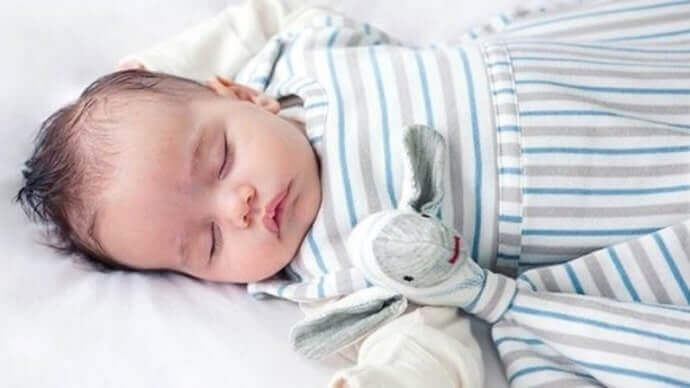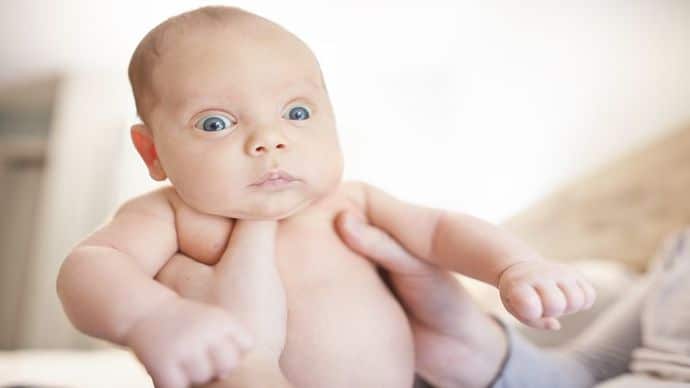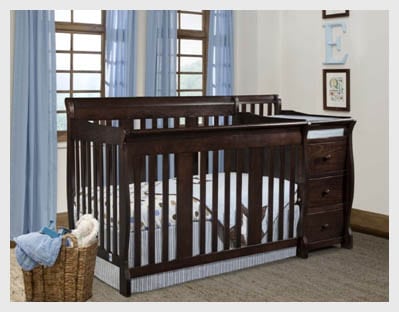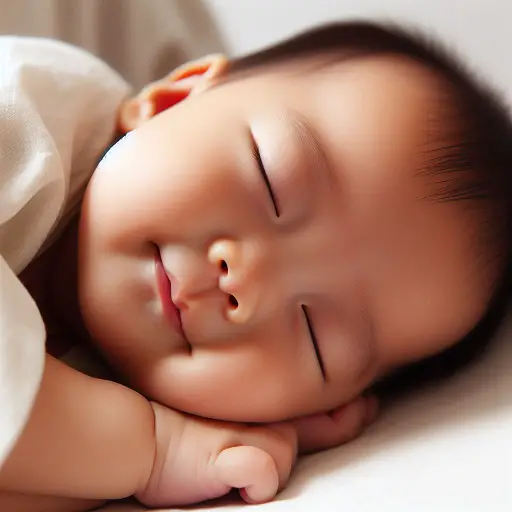It is best to swaddle a newborn baby for sleep whether it is winter or summertime. Just make sure to use the right swaddling technique and ensure your swaddled baby is put to sleep on her back. If the baby has grown passed the newborn stage Moro Reflux (the phase when baby gets startled in sleep and wakes up) it’s best to make the baby sleep in a sleep sack especially in winter.

Sleepsacks ( a wearable blanket for the baby), provides an extra layer of warmth, especially in the cold weather.
Besides, using sleep bags, it is also important to understand what combination of clothes works best for your baby to keep her warm in winter but not too warm.
Guideline For Choosing Baby Clothing Based On A Room’s Temperature
Temperature in Fahrenheit
Less than 60 degree
Between 60 degree to 63 degree
Between 64 to 67
Between 68 to 70
Between 71 to 73
Between 74 to 75
What to put on baby
Gloves, socks, a hat for head protection, pajama, sleepsack
Socks, pajama, Full bodysuit or sleep sack
Pajamas and full bodysuit
Pajamas, Sleepsack with short sleeves
Bodysuit or full-body pajamas
Bodysuit with short sleeves
Before deciding to put the baby to a sleepsack or a sleeping bag (as some moms call it), it’s important to know the TOG rating to understand which one you should choose.
What is TOG rating and how does it help to choose baby’s winter clothing?
TOG (Thermal Overall Grade) is the measuring unit used to calculate the thermal insulation or warmth of clothing. Basically, the higher the TOG warmer the cloth will be.
For example, Aden & Anais well known for their baby products provides a handy Tog Chart (see below) for choosing their sleeping sack for the baby depending on a room’s ambient temperature which depends on many factors including the weather outside, insulation, use of heating and cooling systems and humidity.
So once you get the room temperature measurement for a product you can match it with their sleeping sack to choose which will be the best depending on the TOG Rating.
TOG Rating
Under 1.0 TOG
1.7 TOG
2.5 TOG
3.5 TOG
Recommended Sleepsack
Classic, Organic or silky soft sleeping bag
Ambient Room temperature
75- 81 degree F
24 – 27 degree C
69 – 74 degree F
21 -24 degree C
61 to 68 degree F
16 -20 degree C
54 to 59 degree F
12 to 15 degree C
Alternatively, if you prefer HALO sleepsacks, their TOG ratings are as follows:
Cotton Sleep Sacks: 1.0-1.5 TOG ( for 68-72 degrees F)
Micro-Fleece Sleep Sack: 1.8 – 2.7 TOG (good for the colder rooms, less than 68 degrees F)
Deedee Sleeping Sacks is another good modern choice. Check some of their offers by clicking on each picture below.
Deedee Sleep Nest Sleeping Sack
TOG 2.5 recommended for 64 to 74 degree F
Deedee Sleep Nest Fleece Baby Sleeping Bag
TOG 1.2 recommended for 60 to 64 degree F
Deedee Sleep Nest Travel Quilted Baby Sleeping Bag
With TOG 3.5 good for colder temperature (less than 60 F) indoor as well as outdoor.
How should a sleep sack fit?
Sleepsacks which are actually wearable blankets are sized to fit over pajamas and provides sufficient leg movement. It is recommended that you select a size based on your baby’s current weight and height.
It should not be purchased like other clothing as something that your child will grow into as that would be too loose a fit for the baby’s comfort and safety.
What should baby wear under sleep sack?
Many parents make their baby wear onesies under a sleepsack but what your baby wears under a sleepsack is your personal preference and also depends on the insulation of the sleeping sack you have chosen.
Some babies hate onesies as they would start screaming and screeching anytime you attempt to put anything over their head. It is easier to put them on pajamas as it is easiest to put on a fussy baby.
If you are using the Aden & Anais cozy sleeping bag, or the HALO cotton sleeper or even Deedee Sleep Nest Sleeping Sack it is suggested to use cotton pajamas underneath. Just keep a watch to make sure your child looks comfortable and not too warm.
Your baby may be fine with just a onesie underneath the sack, depending on the room temperature.
What temperature should baby sleep in winter?
With winter approaching, it’s almost a constant thought, especially for first-time mothers, worrying about their baby being cold in the winter nights. She would keep worrying whether her child has kicked off her blankets and is freezing, at the same time become panicky about her being overheated and uncomfortable.
You don’t want your baby’s room to be too hot or too cold. Keeping the temperature between 68 and 72 degrees F is a good range whether it is summer or winter. It is important that you don’t overheat your baby’s room as it increases the risk of SIDS. If you’re worried about the room getting stuffy turn on a fan. It has been studied that a fan can reduce the risk of SIDS by 72 percent.
If you are sleeping in the same room, for you, it could mean turning your thermostat up a little higher than you usually do; but you’ll have better sleep knowing that your baby is warm and comfortable throughout the night without using any risky items like loose blankets or a space heater.
According to the National Sleep Foundation, soft, loose bedding, like blankets, can increase the risk of SIDS. So if your baby is at least not a year old, you may not want to introduce a blanket. Popular alternatives for today’s parents include dressing your little angle in warm pajamas and using a sleep sack to keep them warm.
Always remember, the room just needs to be warm enough for an adult dressed in light clothing, so don’t think you have to jack up the thermostat just to keep your baby nice and toasty. In general, it has been noted that almost everyone seems to sleep better when it’s a little cooler, so it would be fine to put the temperature a degree or two lower than what you originally thought to make sure your baby’s not overheated.
When can my baby sleep with a blanket?
It is suggested that you wait until your baby is at least 12 months old. According to the American Academy of Pediatrics (AAP), “soft bedding in a crib – like blankets and pillows – increases of the risk of suffocation or sudden infant death syndrome (SIDS)”. A safer alternative to the blanket is to make your child sleep in a sleepsack or a wearable blanket.
After your baby is one year old, you can allow her to use a blanket or bring a special toy to bed for comfort. Having said that, it’s still safer to keep her crib relatively empty – so it’s better that you don’t give her a pillow until it is time to transition her from the crib to a bed.
How can you tell if a baby is warm enough?
It’s not always easy to know what the baby is feeling as she cannot express herself in words yet. Ideally, your baby’s body temperature shouldn’t be too hot, nor too cold, but just right.
Here are 5 tips to help you understand whether your baby is comfortable and not too warm.
1. Assess baby’s tummy and chest temperature with your hand
Baby’s temperature can be reasonably assessed by human touch. Finding the body’s core temperature is important for this. So, put your hand on her chest or better yet on her tummy. If it’s nice and warm to touch, and not cold or sweaty, your baby is probably quite comfortable.
2. Put on a head protection cover or beanie when outside
Generally, most babies have very little hair, and heat can be lost through the head. So, it’s a good idea to put on a beanie especially outside the house. In winter this step is particularly important.
3. Add one layer extra than what you are using
One good rule of thumb to properly dress your baby for winter is to add one more layer to the baby than what you’re wearing. An infant needs one more layer of clothing than an adult would wear at the same temperature because the baby’s body has not yet learned to adapt to temperature levels fully yet.
4. If you are changing your layers, adjust your accordingly.
In normal circumstances, unless you are sick, if you’re feeling too cold or too hot, there’s a good probability that your child is feeling the same too. Especially at night, it’s important to adjust her bedding if you’re adjusting yours. She will not be able to just kick off her blankets like you or open up her sleeping sack if feeling hot. So if you’re up to remove your layer, check her temperature and make sure she is not overheated.
5. Check whether the baby’s feet are warm and pink
Previously if a baby’s hands and feet were cool, it was considered okay as the belief was the coolness was due to baby’s immature circulatory system. However, in recent time WHO (World Health Organization) has declared that that baby’s hands and feet should be warm and pink.
Pink and warm feet of the baby is now considered an indication of thermal comfort. But if feet are cold and the trunk is warm it can be an indication that the baby is in cold stress. In the case of hypothermia, both feet and trunk become cold to touch.

“Avoid overheating or overcooling: Keep the room 68°F–72°F (20–22.2°C), and avoid overdressing. Your baby’s ears should feel slightly warm, not cold or hot.”
Should babies wear socks to bed?
Babies generally get stimulated when they are cold, especially at the time of sleeping. It could cause discomfort which will leave the baby restless throughout the winter night. This can be easily avoided by making the baby wear socks to keep her feet warm.
To know whether the baby needs socks, touch her feet. If her feet are colder than the other parts of her body, then it is likely that she needs to wear socks. Always check the body temperature of your baby by feeling her stomach and chest. It is important that the baby stays warm and comfortable all the time which is important for her health and growth.
But, wearing socks every day, throughout, may lead to some serious health risks in the long run. So ensure you put on the socks on the baby only when it’s needed.
What is the right pair of socks for babies?
First of all, ensure it fits perfectly. If socks are too tight it imped normal development of your baby’s feet. Also, it may irritate your baby’s skin and disturb her blood circulation.
The material of the socks chosen for baby is also an important factor to consider. Choose socks made of cotton and/or fiber to prevent any allergic reactions.




